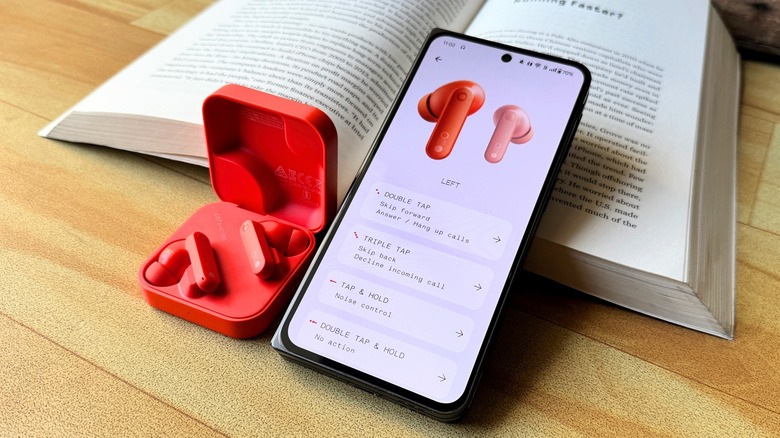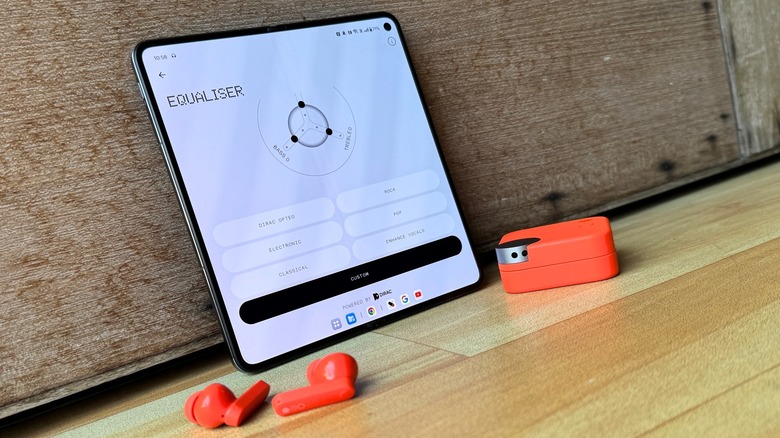CMF Buds Review: Nothing Sub-Brand Low-Price ANC Earbuds For All
- Eye-catching looks
- Comfy fit
- Pleasantly balanced audio output
- Active noise cancellation (ANC)
- Good battery life
- Fast charging
- Transparency mode needs some work
- Lack of granular equalizer tools
- No charging cable included
- Touch-based volume controls are somewhat finicky
We may receive a commission on purchases made from links.
Nothing is not the first brand that comes to mind when it comes to true wireless earbuds. And when your budget is $99 or above, Nothing certainly doesn't make it to many recommendation lists, and for valid reasons. A splashy design, the likes of which we got on the Nothing Ear (2) and the Nothing Ear Stick can only take you so far, particularly for a class of devices that are lodged into your ear canal for listening to music and taking calls instead of making a fashion statement.
The brand, helmed by former OnePlus alum Carl Pei, has now branched out into a wider range of accessories under the CMF by Nothing label. The latest ride to roll out of that garage is CMF Buds, a slightly toned-down variant of the Buds Pro. Priced at $39, the new Buds instantly pique the attention, and this time, it's not just fancy looks, but also substance. For example, the latest CMF buds offer active noise cancellation (ANC), a trait you're unlikely to find in this price bracket.
The rest of the package also seems fairly well-rounded, thanks to facilities such as fast charging, a splash-resistant build, and an intuitive app that seems to cover all the basics. What follows is a detailed breakdown of all the surprises and hiccups that were encountered while testing CMF's latest true wireless earbuds, provided by CMF by Nothing for this review.
Design and build quality
Once again, ostentatious aesthetics meet you right at the gate, with a bad surprise in tow. Nothing offers the CMF Buds in three colors: white, black, and orange. I checked out the white trim at a store and they look and feel fantastic, punching way higher above their market worth. We got the signature orange version for review, which is dazzling, but in a subjectively garish fashion.
Everything here's an all-plastic affair, but the quality is admirable, and so is the attention to detail. The pebble-shaped case has a USB-C port and a large circular power button that gets the earbuds into pairing mode. I'm glad there is no hit-or-miss touch-and-hold system at play here involving the earbuds.
The standout element, however, is the rotating silver wheel. Depending on how much your hyperactivity loathes a fidget spinner, you'll either like it or hate. But it looks unlike anything, and in a good way. It also disguises a pair of holes to latch a lanyard, which is once again a rare trait to see on earbuds.
What's interesting is that Nothing has enough cash to put an aluminum alloy dial on the CMF Buds that only exists as an exquisite design element.
Also unexpected — in a bad way — is the lack of USB-C cable in the retail package. Carl Pei has been vocal about how he holds Apple in high regard and also loves to take potshots at the brand from time to time. Yet, Apple — which more or less started the trend of yanking accessories of the retail package — offers a cable in the AirPods box.
Battery life and call quality
Nothing touts a longevity of eight hours without ANC for the CMF Buds' onboard 45 mAh battery, while the charging case takes those numbers to over 35 hours. Fast charging support ensures that ten minutes of plugged-in time delivers over 6 hours of listening time. Those promises seem to reflect well on a day-to-day basis. In the most recent test run, the CMF Buds only dropped to 60% from a full tank, after nearly two and half hours of continuous music listening with noise canceling enabled and the volume levels alternating between 60 and 70 percent.
However, do keep in mind that enabling dual device connectivity brings down the battery longevity figures significantly. Also, long calls take their own sweet tool on the battery life, as transparency mode is enabled by default for voice calls. But as far as quality goes, the person on the other end was able to hear my voice even as I was walking on a breezy terrace with a loose cap over my ears.
Another neat convenience is the lost-and-find system. Labeled as Find My earbuds in the companion app, it plays a loud audible tune from the onboard 12.4mm driver to help you find the earbuds, in case you misplaced them. This one isn't quite like Apple's Find My — or the equivalent solutions offered by Samsung and Google — that rely on geolocation and Bluetooth pings. And at this sticker price, we can't realistically expect it. But I'm glad it's there – it comes in handy when you can't quite remember which drawer or sofa you left the earbuds on during the most recent listening session.
Fit and features
The CMF Buds embrace the same angled look for the head as its pricier Pro sibling. The stem isn't obnoxiously long, unlike the original AirPods, and thanks to its flat profile, it's a lot more reliable for executing tap-and-hold gestures. The earbuds only weigh 4.57 grams, and you won't feel their heft on the ear muscles. Moreover, the fit is comfortably snug and they don't fall out if you're hastily prancing on the stairs or out for a jog.
Nothing has done a respectable job with the software running the show on its latest audio wearable. Connectivity is handled by Bluetooth v5.3, with Fast Pair support to go with it. Notably, you get support for dual-device connection tech as well as compatibility with Microsoft's Swift Pair system for Windows PCs. It's a thoughtful addition that removes the hassle of a jarring Bluetooth pairing process.
The Nothing X app serves as the bridge here, and it's one of the nicest and best-designed wearable apps I've used in a long time. Other features include in-ear detection, which intelligently pauses or resumes music playback when you take off the earbuds or pop them back in.
The Nothing X app is where you also customize the double/triple tap and hold gestures for controlling playback, taking calls, and switching between ANC and transparency modes. These gestures work just fine, but volume adjustment can be a chore as it needs a double tap + hold action, which is slow and not as comfortable as sliding vertically on the stem.
Audio controls
The Nothing X app offers a healthy bunch of audio-centric features. Nothing offers a total of six equalizer presets, and they've been tuned fairly well across three core metrics: bass, treble, and mids. Irrespective of the genre you're listening to, each preset gives its own special twist to the audio output, one that is easily noticeable. The best one, however, is the Dirac Optio mode.
Think of it like a rudimentary spatial audio tuning without any head tracking. In the simplest terms, picking this one as your default equalizer preset offers an extra dash depth, a simulated surround feel, and a little bit of added oomph to the bass and trebles. Depending on your listening preferences, you can pick between rock, pop, electronic, classical, and enhanced vocal presets.
Then there's the custom option, which allows a limited scope of equalizer customization across bass, treble, and mid-levels. It's not a full-fledged equalizer in practical terms, as it doesn't let you play with crucial metrics such as frequency range and intensity. For any audio purist, that's a big miss, but then you also have to take into consideration the hardware at your disposal and the price segment we are exploring. Likewise, there are no controls for the four mics, two each for the left and right earbuds.
Noise Cancellation and Transparency
At nearly 70% volume level, the earbuds managed to drown the human chatter in a packed coffee shop. That's not bad for the price. It's one of the most satisfying executions of ANC I've ever come across on earbuds that cost less than $50. In traffic, I had to bump up the volume levels, but the earbuds were able to silence the hum of motorcycles, auto rickshaws, and cards around. I found it performing well in almost all the scenarios where I tested the OnePlus Buds 3, albeit not to the same kind of isolation experience as the pricier OnePlus earbuds. In a nutshell, it gets the job done, but don't expect anything eye-opening, the way you get to experience ANC on the AirPods Pro or Sony's WF-1000 XM4 flagship earbuds, which cost over six times as much.
The transparency mode, on the other hand, could use some work. This mode does a decent job of opening the audio channels to ambient sound, but it struggles with delivering clear vocals. I found it to work best when the sound level was set between 40 to 60 percent levels. Once again, I'd much rather have this facility of my earbuds, than not having access at all.
Instead, Nothing says it has created a physical tunnel system at the bottom of the steam that allows wind to pass unhindered and keeps it from affecting call quality. Then we separate controls for ANC and transparency mode, which can be toggled from within the app as well as tap-and-hold gestures. There's nothing fancy like ear canal testing for creating a personalized audio experience, the kind you come across on OnePlus earbuds.
The listening experience
If I were to describe the CMF Buds' raw audio performance, I'd call it pleasantly balanced. Despite the emphasis on bass output in the marketing materials, these earbuds are not bass-forward at all in their natural state. However, if you tweak the equalizer settings, it does kick things a notch higher. What I loved the most about these earbuds is that even at high volume levels, there is very little distortion to be felt in the vocals, but there are still a few weak points.
At instrumental trap beats or tracks with a lot of synths, the treble goes a tad overboard and suppresses other frequencies. It doesn't reach a level where you'd want to throw the earbuds away, but if your equalizer settings have treble set to the highest level, make sure to make at least a comparable adjustment to the mids in order to keep the songs from sounding too synthetic and shrill. In a nutshell, keep the equalizer tweaks modest, or stick with the Dirac Opteo mode. For some tracks, shifting from the Dirac Opteo mode offers a wider soundstage and more depth to the music, but it ultimately leans more on the instrumental and vocal temper of the track.
Take for example the "Anthem" soundtrack by Sarah Schachner, which makes liberal use of electronic incursions and lots of treble-leaning synth beats. It plays just fine on the Dirac Opteo profile. But if the treble and bass adjustments are too heavy-handed, some of the tracks like "Valor" start sounding like lopsided sonic jargon. But overall, there are no serious red flags here that would have you look away from the CMF earbuds.
The bass situation
The vocals enhanced mode does what the name suggests, but the hit it takes on the raw bass and instrumental depth is not worth it, unless you really want to separate the vocals. For example, if you enjoy genre-defying ethnomusicological tracks with elements like guttural and overtone vocal notes, the Enhance Vocals mode is worth trying out. But the Dirac Opteo mode still does a decent job of keeping the vocals discernible without muddying the rest of the instruments, especially if you don't want to miss out on the exotic notes of instruments like ravanahatha, santoor, and hang drum.
In "Majdan," a track from experimental folk music band Heilung that also featured on the "Hellblade II" soundtrack, turned out to be a hauntingly beautiful experience on the CMF Buds. It's a complex track for any audio gear to do justice, but in my experience, maxing out the treble and bass while keeping the mids at neutral in the custom equalizer proved to be the winning combination.
For R&B tracks like Pop Smoke's "Shake the Room," once again, the custom equalizer offers the most enriching experience, amplifying those sleeper bass thumps without muddying the vocals or flattening other notes. The whole approach is a tad brute and might feel a bit overwhelming, but if bass is your priority, these earbuds won't disappoint. It's just odd that you won't feel much of a difference when enabling it unless you really want to hear the slight lift. For the tracks that I tried, this feature only seemed to add a tinge of directional approach to the bass notes but didn't really add any noticeable thump to the music.
Final words
The latest CMF Buds offer a fairly well-rounded package that is already well ahead of the competition on meaningful metrics, Pair that with an eye-catching comfortable design and a lovely, and you get a pair of earbuds that are absolutely worth their ask. The audio output is satisfactory with a few high points, calling is a reliable experience, and the battery life doesn't disappoint either.
Nothing has promised that these CMF Buds are coming to the US market carrying a sticker price of $39, likely inside of April 2024. For that amount of money, you don't get many options in competing earbuds that offer perks like ANC, decent software, and balanced audio.
But if you must, and you absolutely need ANC, you should look at the JVC Marshmallow, Anker Soundcore Space A40, SoundPeats Air 3, Edifier TWS1 Pro 2, and the Baseus Bowie MA10. But keep in mind: each is set back by a buggy app, lack of software niceties, or some issues with the raw audio output.
In case noise cancellation isn't a must-have for your budget earbuds hunt under $50, Jabra Elite 3, Amazon Echo Buds (2023), or the excellent JLab JBuds Mini. But if we talk solely based on merits — and the expected omission of facilities like wireless charging — Nothing's CMF Buds come out as a solid pair of inexpensive earbuds that consistently deliver performance and value well above their original asking price.








